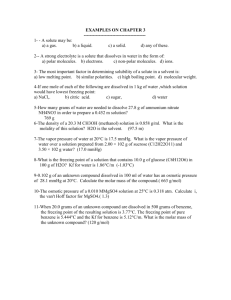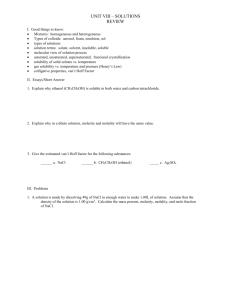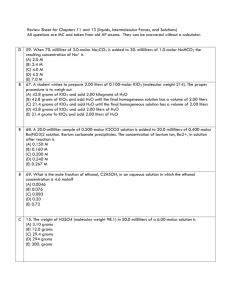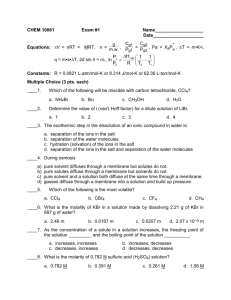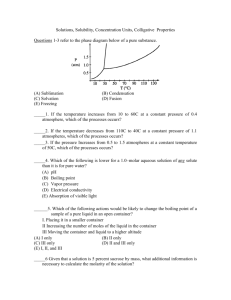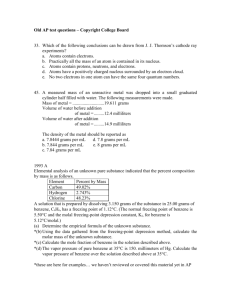File
advertisement
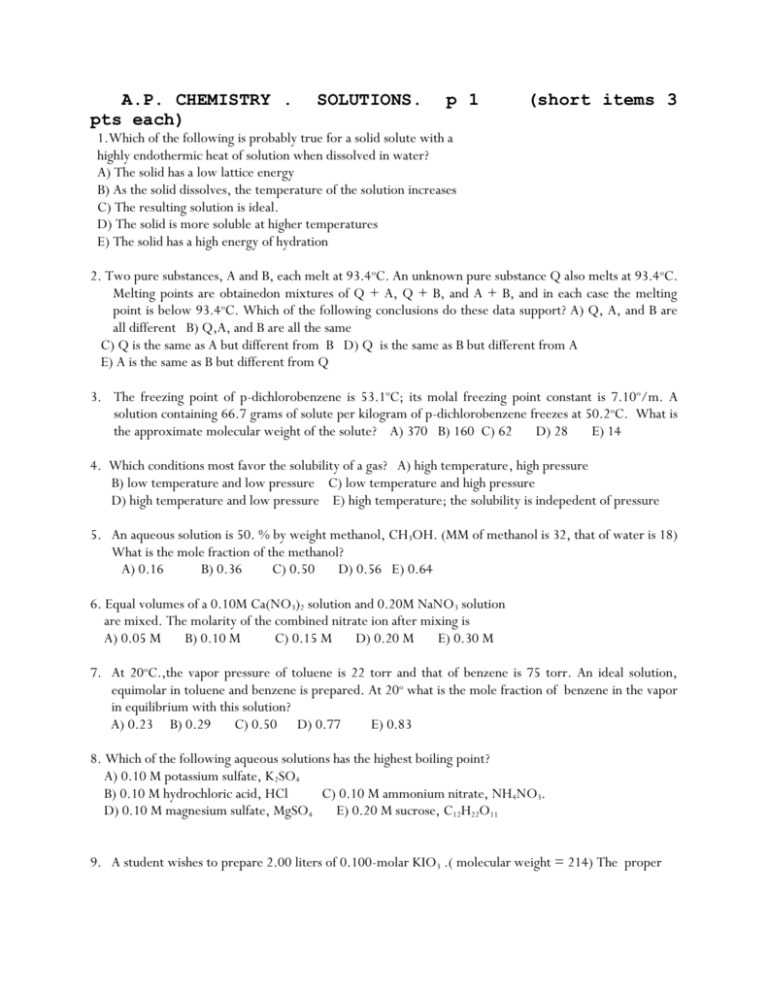
A.P. CHEMISTRY . pts each) SOLUTIONS. p 1 (short items 3 1.Which of the following is probably true for a solid solute with a highly endothermic heat of solution when dissolved in water? A) The solid has a low lattice energy B) As the solid dissolves, the temperature of the solution increases C) The resulting solution is ideal. D) The solid is more soluble at higher temperatures E) The solid has a high energy of hydration 2. Two pure substances, A and B, each melt at 93.4oC. An unknown pure substance Q also melts at 93.4oC. Melting points are obtainedon mixtures of Q + A, Q + B, and A + B, and in each case the melting point is below 93.4oC. Which of the following conclusions do these data support? A) Q, A, and B are all different B) Q,A, and B are all the same C) Q is the same as A but different from B D) Q is the same as B but different from A E) A is the same as B but different from Q 3. The freezing point of p-dichlorobenzene is 53.1oC; its molal freezing point constant is 7.10o/m. A solution containing 66.7 grams of solute per kilogram of p-dichlorobenzene freezes at 50.2oC. What is the approximate molecular weight of the solute? A) 370 B) 160 C) 62 D) 28 E) 14 4. Which conditions most favor the solubility of a gas? A) high temperature, high pressure B) low temperature and low pressure C) low temperature and high pressure D) high temperature and low pressure E) high temperature; the solubility is indepedent of pressure 5. An aqueous solution is 50. % by weight methanol, CH3OH. (MM of methanol is 32, that of water is 18) What is the mole fraction of the methanol? A) 0.16 B) 0.36 C) 0.50 D) 0.56 E) 0.64 6. Equal volumes of a 0.10M Ca(NO3)2 solution and 0.20M NaNO3 solution are mixed. The molarity of the combined nitrate ion after mixing is A) 0.05 M B) 0.10 M C) 0.15 M D) 0.20 M E) 0.30 M 7. At 20oC.,the vapor pressure of toluene is 22 torr and that of benzene is 75 torr. An ideal solution, equimolar in toluene and benzene is prepared. At 20o what is the mole fraction of benzene in the vapor in equilibrium with this solution? A) 0.23 B) 0.29 C) 0.50 D) 0.77 E) 0.83 8. Which of the following aqueous solutions has the highest boiling point? A) 0.10 M potassium sulfate, K2SO4 B) 0.10 M hydrochloric acid, HCl C) 0.10 M ammonium nitrate, NH4NO3. D) 0.10 M magnesium sulfate, MgSO4 E) 0.20 M sucrose, C12H22O11 9. A student wishes to prepare 2.00 liters of 0.100-molar KIO3 .( molecular weight = 214) The proper A.P. CHEMISTRY . SOLUTIONS. p 2 procedure is to weigh out A) 42.8 grams of KIO3 and add 2.00 kg of H2O B) 42.8 g. of KIO3 and add H2O until the final homogeneous solution has a volume of 2.00 liters D) 42.8 grams of KIO3 and add 2.00 liters of H2O E) 21.4 grams of KIO3 and add 2.00 liters of H2O 10. How much water must be added to 100. ml. of 3.0 M NaOH to produce a 0.50 M solution? A) 500 ml B) 600 ml. C) 300 ml. D) 6.0 liter E) 5.0 liter 11. Liquid Q is a polar solvent, while liquid R is a nonpolar solvent. On the basis of this information you would expect A. Both liquids to be miscible in the same third liquid T. B. Liquid Q to be miscible with water C. Liquid Q to be miscible with liquid R D) CCl4 to be immiscible in both liquid Q and liquid R E) NaCl to be soluble in both Q and R. 12-13. Liquids A and B form an ideal mixture. At 20o the vapor pressure of pure A is 100 mm.; that of pure B is 50 mm. A solution contains 2.0 moles of A and 8.0 moles of B. 12. What is the partial pressure of vapor A in equilibrium with this solution? A) 20 mm B) 25 mm C) 10 mm D) 40 mm E) 60 mm 13. What is the mole fraction of A in the vapor above the solution ? A)0.20 B) 0.25 C) 0.33 D) 0.67 E) 0.80 14. How many grams of silver nitrate,(m.w.=170) are required to prepare 25 ml. of a 0.15 M solution? A) 6.4 g B) 0.64g C) 1.02 g D) 10.2 g E) 2.2 g 15. The vapor pressure of water at 50o is 92.5 mm of Hg. What is the vapor pressure of a solution containing 180.0 g of glucose, (mw=180) dissolved in 180 g of water? A) 84.1 mm B) 83.2 mm C) 46.2 mm D) 103 mm E) 9.25 mm 16. Assuming that the solution is ideal, what is the boiling point of an aqueous NaCl solution which freezes at -0.41oC? (The freezing point constant is 1.86o; the boiling point constant is 0.52o) A) 100.15o B) 100.22o C) 100.06o D) 99.78o E) 100.11o 17. Although the dissolving of KNO3 in water is endothermic, the salt is quite soluble. This is because A) the bonds that are broken are stronger than the bonds that are formed B) the bonds that are formed are stronger than the bonds that are broken C) 21.4 g. of KI A.P. CHEMISTRY . pts each) SOLUTIONS. p 3 (short items 3 C) the dissolving process results in an increase in entropy D) the dissolving process results in a decrease in entropy E) endothermic changes are generally spontaneous at room temperature. 18. For the dissolving of LiBr in water, the hydration energy is greater in absolute value than the lattice energy. From this information, one can conclude that A) LiBr is nearly insoluble in water B) the dissolving process is endothermic C) the dissolving process is exothermic D) the solubility of LiBr increases with increased temperature E) the solubility of LiBr increases with increased pressure. 19. A cellophane bag, which acts as a membrane permeable only to water, (permitting osmosis) contains a 2 M sugar solution. The bag is immersed in a 1 M sugar solution. What will happen? A) The bag will soon contain more solution that will be less concentrated than 2 M B) The bag will soon contain more solution that will be less concentrated than 2 M C) The bag will lose sugar and the solution in it will become less concentrated D) The bag will lose water and the solution in it will become more concentrated E) There will be no change 20. The solubility of oxygen in water at 18°C and 1 atm pressure is 0.0450 g/L. How many grams of oxygen at 10.0 atm pressure will dissolve in 500 mL of water at 18° ? 21. What mass of water is needed to dissolve 292.5 g of NaCl (MM = 58.5 g/mol) to produce a 0.25 m aqueous solution? A) 5.0 kg B) 20. kg C) 0.80 kg D) 0.050 kg E) 10. kg 22. Which formula is possible for a completely ionized salt if an aqueous 0.10 M solution of that salt has a freezing point of 0.74°C ? ( Kf for water is 1.86°/m) A) MX B) M2X C) MX3 D) M2X3 E) MX2 I. A solution containing 12.0 g of solute dissolved in 800 g of water freezes at -0.607o C. What is the molecular weight of the solute? The solution boils at a temperature of 90 o. What conclusion can you draw about the nature of the solute? ( 5 pts) II. Concentrated solutions of NH3 in water are 28 % NH3 by weight, and have a density of 0.90 g/ ml. Find ( 12 pts) a) The molarity of NH3 in the solution b) the molality of NH3 in the solution c) the mole fraction of WATER in the solution. d) the freezing point of the solution, if the ionization of the NH3 is negligible. III. Alcohol dissolves in water to give a solution that boils at a lower temperature than pure water. Salt A.P. CHEMISTRY . SOLUTIONS. p 4 dissolves in water to give a solution that boils at a higher temperature than pure water. Explain these facts from the standpoint of vapor pressure. ( 4 pts_ IV. The freezing point and electrical conductivities of three aqueous solutions are given below. Solution (0.010 molal) Freezing point _____________ Electrical Conductivity ___________________ sucrose 0.0186°C almost zero formic acid 0.0213°C low sodium formate 0.0361°C high Explain the relationship between the freezing point and the electrical conductivity for each of the solutions above. Account for the differences in the freezing points among the three solutions. ( 4 pts) V. An organic liquid is found to have the empirical formula C3H2Cl. (in the original AP problem you were given the % comp. and asked to find the empirical formula as the first step) A solution is prepared by dissolving 3.150 grams of this substance in 25.00 grams of benzene, C 6H6 . The solution has a freezing point of 1.12°C. The normal freezing point of benzene is 5.50°C and the molal freezing point constant, Kf for benzene is 5.12°/m . (10 pts) a) Using the data from the freezing point depression, find the molar mass of the unknown liquid. b) Find the actual molecular formula of the liquid. c) Calculate the mole fraction of benzene in the solution above. d) The vapor pressure of pure benzene at 35°C is 150 mm of Hg. Calculate the vapor pressure of benzene over the solution described above at 35°C. VI.Assuming that the water is at the same temperature, how would the solubility of oxygen in a lake in Denver compare with the solubility of oxygen in a lake in Central Park? Explain briefly. ( 3 pts)
